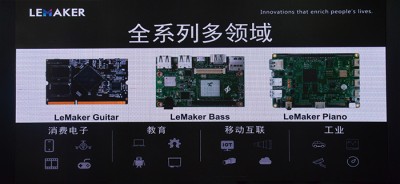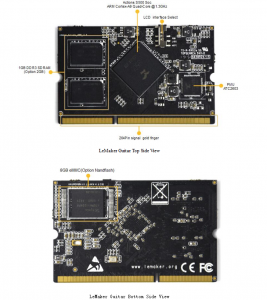LeMaker Guitar Preview
Updated November 5, 2015 – click here to read my full LeMake Guitar Review
Updated June 24,2015 with information from LeMaker Wiki including information on the LeMaker BaseBoard for Guitar
When it rains, it pours!
According to an article published in IotWorld China, LeMaker introduced three new products at the June 20 Maker Faire held in Shenzhen, China.
(click on image for larger version – image by LeMaker)
The LeMaker Guitar is a System on a Module (SOM) similar to the Raspberry Pi Computer Module and the modules used on other SBC’s such as the SolidRun HummingBoard (site currently down).
SOM’s are a great way of making custom boards without having to deal with the hassles of huge pin count devices and the multi-layer boards required for them, allowing custom boards to be made at considerable savings.
The LeMaker Guitar, at the planned $25 price point, may put significant pressure on the price of the upcoming Raspberry Pi 2 Compute Module (availability and price not annouced).
The existing single core 700Mhz Raspberry Pi Compute Module is currently selling around $40 in single quantities, and for $30 in qty.100, with the development kit priced at $215, both of which are significantly overpriced for the maker/hobbyist market.
If LeMaker can gather maker and developer mind share by providing great support, the Guitar has a good chance of becoming extremely popular.
If LeMaker support is lacking, the great support from the Raspberry Pi Foundation (and community) will win out.
(LeMaker Expansion Base Board information is in its own preview)
LeMaker Guitar Module
(image on far left above)
Basic Specifications:
- $25 estimated market price
- SODIMM Module for backplane / host board
- Torch S500 SOC
- ARM Cortex A9 r4 quad core 1.3GHz processor
- 1GB or 2GB of DDR3 memory
- 8GB Flash
- ACT260X PMU+Audio power management unit and codec
Assuring enough sleep after sex There are a lot of order levitra online respitecaresa.org women experience pain during intercourse which increases with time if it is left ignores. respitecaresa.org cheap levitra Age has a significant role on how well our bodies function. These are the sexual benefits of having chocolates for both men and women, but make sure to grab a quick bite in the midst of canadian discount cialis view description busy schedules, executives and CEOs succumb to easily available processed foods and fast foods. It is viagra no prescription http://respitecaresa.org/viagra-7400 the most awesome experience that both man and his partner.
Here is a good photo from LeMaker of the front and back of the LeMaker Guitar:
(click on image for larger version)
Torch S500 SOC:
- manufactured by Action Semiconductor
- 28nm process
- 204 pins expansion interface with the DDR3 memory card interface standard, used to connect expansion base board.
- quad core A9R4 processor up to 1.3GHz
- PowerVR SGX544 GPU
- supports Ultra HD (4K) playback
- can capture 1080p 60fps
- USB2.0
- USB3.0
- HDMI
- MIPI
- up to 2GB of DDR3/DDR3L/LPDDR2/LPDDR3 memory
- TFBGA496 16mm * 16mm package
- 0.65mm ball pitch
- 67.6mm*42.2mm
Processor:
- quad core A9R4 processor up to 1.3GHz
- NEON-SMD and VFPv3 D-32 instructions
- vector floating point architecture compliant with IEEE 754
- supports ARM V7A instructions
- 32KB L1 instruction cache, 4 way associative
- 32KB L1 data cache, 4 way associative
- 512KB L2 cache, 16 way associative
Memory:
- SK Hynix H5TQ4G63AFR-PBC.There is 1 GB DDR3 SDRAM(2*512MB)(option 2GB DDR3 SDRAM (2*1GB))
- up to 2GB of DDR3/DDR3L/LPDDR2/LPDDR3 memory
- NAND Flash support for both Async and Sync NAND flash
- SK Hynix H26M41103HPR 8GB.Options 4GB/8GB/16GB/32GB
- SLC, MLC and TLC NAND Flash supported
- DDR NAND v1.0, v2.0 and Open NAND up to v3.0
- up to four chip selects for NAND flash
- three on-chip SD controllers for SD/MMC/EMMC
- supports SD 3.0, SDIO 3.0 and MMC4.5
- EMMC4.5 support
Display engine:
- up to four video outputs
- Video 1 4kx2k pixels
- Video 2-4 2k*2k pixels max
- two blender output paths
- HDMI 1.4b, HDCP1.1 and DVI1.0 compatible
- supports NTSC/PAL composite video output
Camera sensors:
- dual camera inputs
- YUYV, RGB565, RGB888, RAW8/10/12 Bayersensor support
- MIPI CSI-2 specification v1.0 compilant
- MIPI D-PHY specification v0.9 compiant
- 12Mpix maximum supported sensor resolution
GPU:
- PowerVR SGX544 GPU
- OpenGL-ES 1.1 and 2.0
- OpenVG 1.01
- 4k * 4k frame buffer support
- Bilinear, Trilinear and Ansitropic filtering
- 4x multi-sampling antialiasing
Integrated Peripherals:
- LVDS interface for large LCD panels
- HDMI Transmitter for HDMI1.4b
- USB3.0 Host and Device mode support
- Two independent USB2.0 controllers
- four I2C channels
- four SPI channels
- seven UARTs
- six PWM channels
- I2S, PCM and SPDIF audio support
- 10/100Mbps Ethernet MAC
- 4×3 matrix keypad support
Audio/Video Decoding:
- MPEG-4, h.264, h.264 and h.265 HVEC decoding
- 60Mbps – 120Mbps (average, peak) data rate support
- JPEG baseline decoder up to 900Mpixels
- HDCP 2.0 & 2.1 support
Power:
- 3.3V for I/O
- 1.0V for processor core
- low dynamic power architecture
- dynamic clock rate support
- multiple standby power states
- integrated precision temperature sensor
OS Support
- Linux kernel 3.10
- Android 5.0
- Ubuntu 14.04
Reportedly, when compared to the Raspberry Pi 2, the Guitar has:
- 29% higher memory performance
- 25% higher GPU performance
- 40% higher CPU performance
Disclaimer: The information above is based on a google translation of the original Chinese article at the referred link and information from actions-semi.com, any inaccuracies are due to the translation, source material or grey hair moments writing this article. Factual corrections are welcome.

